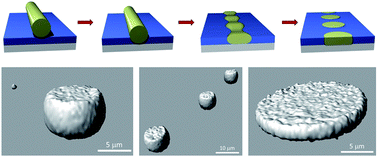Rayleigh-instability-driven morphology transformation of electrospun polymer fibers imaged by in situ optical microscopy and stimulated Raman scattering microscopy†
Abstract
Electrospinning is one of the most common methods to prepare polymer fibers with sizes ranging from several nanometers to hundreds of micrometers. In most studies of electrospun polymer fibers, the properties and morphologies of polymer fibers are controlled by changing the electrospinning conditions. Few studies focus on the post-treatments of polymer fibers, which are critical for many fiber-based applications. In this work, we investigate the morphology transformation of electrospun polystyrene (PS) fibers annealed on top of poly(methyl methacrylate) (PMMA) film-coated glass substrates. In situ optical microscopy and stimulated Raman scattering (SRS) microscopy are used to observe the transformation process, which is driven by the Rayleigh instability, the surface tensions, and the interfacial tensions of polymers. Depending on the thickness of the underlying PMMA films, the electrospun PS fibers may transform into hemispheres or disks. The growth rates of the undulating amplitude are also affected by the film thickness.


 Please wait while we load your content...
Please wait while we load your content...